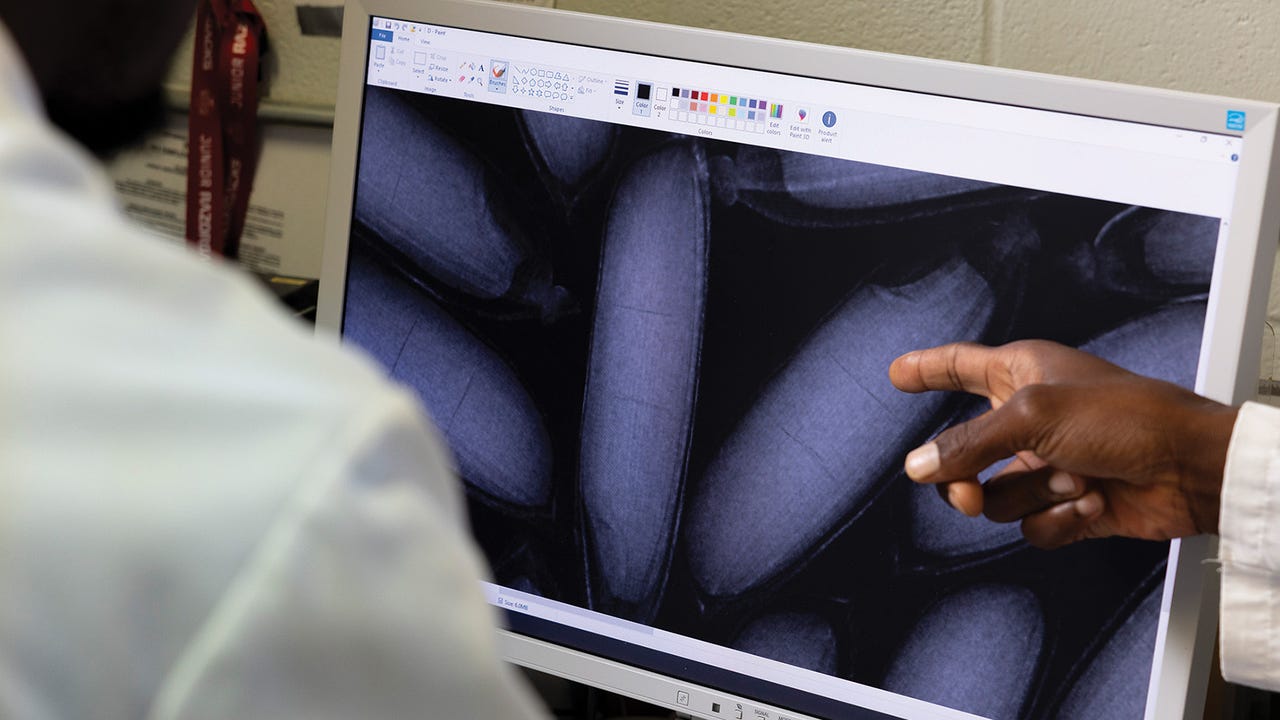Tags
Good seed rice quality directly influences crop success
An Arkansas Rice Processing Program study compared drying conditions for seed rice performance using X-ray imaging.
John Lovett, Science Writer, University of Arkansas System Division of Agriculture

At a Glance
- Arkansas Rice Processing Program employs X-ray imaging to examine fissuring.
- Lack of statistical significance seen between fissuring and seed vigor.
- Insight gained on impact of harvest moisture content, high-heat drying on germination.
Rice grown for seed rice was the focus of a yearlong Arkansas Rice Processing Program investigation using X-ray imaging to determine the impact of higher drying temperatures.
While quality defects such as opacity and small cracks called fissures are key measures for rice grown to eat, rice saved for seed is evaluated on two critical factors: germination potential and seed vigor.
Germination potential measures what percentage of rice seed will germinate and sprout, according to Griffiths Atungulu, director of the Rice Processing Program for the Arkansas Agricultural Experiment Station. Seed vigor indicates how fast it will germinate and whether the seedling will develop into a healthy plant.
“Good seed quality directly influences crop success and is crucial in improving productivity levels,” said Atungulu, who is also a professor in the food science department for the experiment station and the University of Arkansas. “As we often say here, every seed counts.”

FISSURE FACTOR — X-ray images allow a noninvasive view of rice through the outer hull to examine cracks in the rice called fissures.
Samuel Olaoni, a doctoral student in the food science department under Atungulu’s advisement, sought to determine the optimum drying parameters for seed rice. For two long-grain rice varieties, the research showed that moisture content at the time of harvest had more effect on both germination and seed vigor than drying temperatures.
His study, “Use of X-ray imaging to elucidate impacts of drying conditions and storage on seed rice germination and vigor,” was published in the journal Drying Technology in July. Atungulu and Kaushik Luthra, assistant professor of postharvest processing, were co-authors.
The study calculated germination rates of about 95% with good seed vigor when harvested at 13% to 16% moisture followed by drying conditions of 122 degrees F and 35% relative humidity. Germination rates of up to 90% were also still seen when dried at 140 degrees, which was the high end for this study.
“The experiment gave us confidence that the higher temperature will work in the end,” Olaoni said. “And the higher temperature will allow the processors to dry it faster without affecting germination too much. Time and cost are very important for the industry to get it done as quickly as possible without damaging the seed.”
Holistic view
Seeds dried at 35% and 50% relative humidity had higher seed germination than those dried at 25%, although with a slight difference of about 2 percentage points. Olaoni said the difference may be due to the drying effect, since a lower relative humidity would induce more stress on the seed than a higher humidity.
While there have been many studies looking at the effect of temperature on seed viability and vigor, Olaoni noted that less research has been done on the impact of relative humidity as a factor alongside temperature, air velocity, kernel fissuring and storage duration.
The two long-grain rice varieties used in the study were harvested at three moisture content levels: 21% to 24%, 18% to 20%, and 13% to 16%. The rice was then dried to 12.5% moisture at temperatures ranging from about 100 to 140 degrees Fahrenheit, with relative humidity levels of 25% to 50%, and air velocity levels of 0.66 to 1.65 meters per second. A scale in the dryer weighed the samples to determine the moisture content.
Rice growers typically harvest rice at a moisture content of 18% to 20% and store the rice in large bins during the drying process to further reduce moisture content, Atungulu said. The optimum storage level of 12.5% moisture content wards off mold growth and helps maintain the rice’s structural quality.
Out fissuring
X-ray imaging was used as a noninvasive tool to see through the outer hull and examine rice grains for fissures before and after drying.
Olaoni’s previous research, published by the American Society of Agricultural and Biological Engineers, has shown that fissuring can impact seed rice germination and vigor depending on the severity and proximity to the embryo and the specific rice variety.
There was a weak correlation and lack of statistical significance between kernel fissuring and seed vigor in this study. Although seeds that fissured less had higher germination rates, the difference in germination rates between seeds with higher and lower percentages of fissuring was about 3.5%.
Seed storage
Seed assessment tests were conducted at three, six, nine and 12 months of storage at room temperature — about 68 degrees F — with relative humidity levels of 25%, 35% and 50%. There were no significant differences in germination rates or seed vigor between storage times and relative humidity levels in this study. However, there was more of a general decline in seed vigor during storage for the rice that was dried at higher temperatures compared to lower temperatures.
Overall, the authors noted that it was critical to dry the seeds to a safe moisture content of 12.5% before storage to minimize loss due to oxidation, enzymatic activity and respiration during storage.
The experiment station is the research arm of the University of Arkansas System Division of Agriculture. This study was supported in part by the USDA’s National Institute of Food and Agriculture Hatch Act funding.
https://www.farmprogress.com/rice/good-seed-rice-quality-directly-influences-crop-successPublished Date: October 10, 2025






